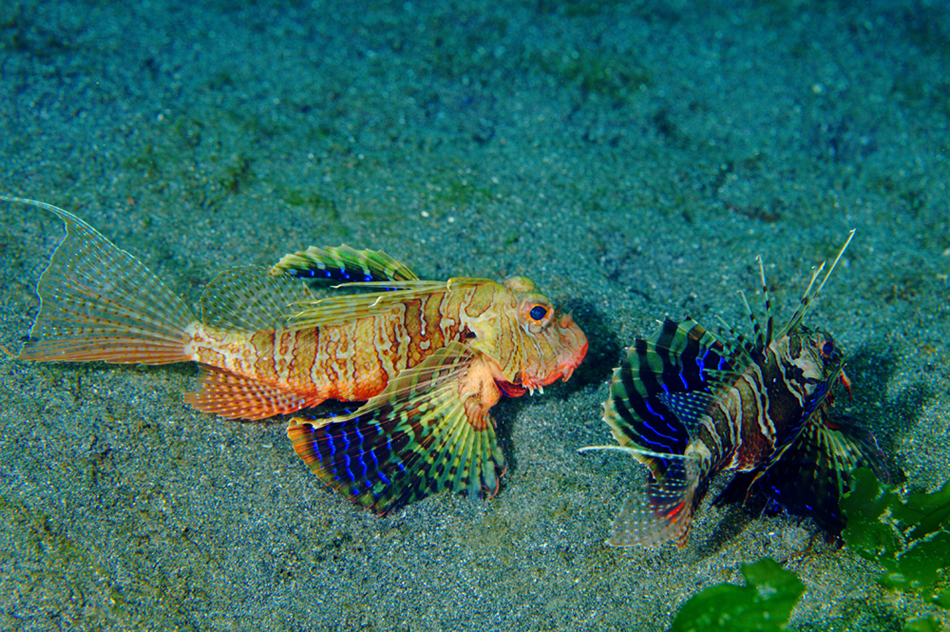Blackfoot Lionfish, Parapterois heterura (Bleeker 1856)

A pair of Blackfoot Firefish, Parapterois heterura, at Gilimanuk, Bali, Indonesia. Source: Klaus Stiefel / Flickr. License: CC BY Attribution-Noncommercial
Blackfoot Lionfish, Parapterois heterura (Bleeker 1856)
More Info
|
Distribution |
Houtman Abrolhos, Western Australia, to Ashmore Reef in the Timor Sea. Elsewhere the species occurs in the tropical, East Indo-West Pacific: Andaman Sea (off Myanmar and Thailand), Indonesia, the Philippines, Malaysia (Borneo), Gulf of Thailand, Vietnam, Taiwan and Japan. Inhabits sheltered inshore and deeper offshore reefs, usually in fine sandy or muddy areas. Individuals sometimes lie partly buried in the substrate. |
|
Features |
Dorsal fin XIII, 9; Anal fin II, 7-8. Dorsal fin spines and outer caudal-fin rays with filamentous tips. |
|
Size |
To 23 cm total length |
|
Feeding |
A nocturnal predator - feeds on benthic invertebrates and small fishes. Like other pteroine fishes, this voracious predator uses its large pectoral fins to corner prey when hunting. |
|
Fisheries |
Of no interest to fisheries, although may be taken as by-catch in commercial trawls. |
|
Remarks |
The pectoral fins are brightly coloured and may be used to ward off potential predators. |
|
Etymology |
The specific name heterura is from the Greek hetero (= different) and oura (= tailed) in reference to the very long caudal fin with an elongate filament on the upper ray. |
|
Species Citation |
Pterois heterurus Bleeker 1856, Acta Societatis Regiae Scientiarum Indo-Neêrlandicae 1: 33. Type locality: Ambon, Molucca Islands, Indonesia. |
|
Author |
Bray, D.J. 2022 |
|
Resources |
Blackfoot Lionfish, Parapterois heterura (Bleeker 1856)
References
Allen, G.R. & Erdmann, M.V. 2012. Reef fishes of the East Indies. Perth : Tropical Reef Research 3 vols, 1260 pp.
Bleeker, P. 1856. Beschrijvingen van nieuwe en weinig bekende vischsoorten van Amboina, verzameld op eene reis door den Molukschen Archipel, gedaan in het gevolg van den Gouverneur-Generaal Duymaer van Twist in September en October 1855. Acta Societatis Scientiarum Indo-Neerlandicae 1: 1-76. See ref online
Bleeker, P. 1876. Genera familiae Scorpaenoideorum conspectus analyticus. Verslagen en Mededeelingen der Koninklijke Akademie van Wetenschappen (Afdeeling Natuurjunde). Amsterdam 2 9: 294-300.
Kuiter, R.H. & Tonozuka, T. 2001. Pictorial guide to Indonesian reef fishes. Part 1. Eels - Snappers, Muraenidae - Lutjanidae. Seaford, Australia : Zoonetics, 302 pp.
Matsunuma, M. & Motomura, H. 2022. Revision of the genus Parapterois (Scorpaenidae: Pteroinae) and resurrection of Parapterois nigripinnis (Gilchrist 1904). Ichthyological Research 69: 401-432 https://doi.org/10.1007/s10228-021-00845-y
Motomura, H. 2004. Morphological comparison of a poorly known scorpionfish, Parapterois macrura, with a related species, P. heterura (Scorpaenidae: Pteroinae). Zoological Studies 43(1): 1-7
Motomura, H., Matsuura, K. & Khan, M. 2018. Parapterois heterura. The IUCN Red List of Threatened Species 2018: e.T114177614A115022647. https://dx.doi.org/10.2305/IUCN.UK.2018-2.RLTS.T114177614A115022647.en. Accessed on 09 February 2022.
Poss, S.G. 1999. Families Scorpaenidae, Caracanthidae, Aploactinidae. pp. 2291-2358 in Carpenter, K.E. & Niem, T.H. (eds) The Living Marine Resources of the Western Central Pacific. FAO Species Identification Guide for Fisheries Purposes. Rome : FAO Vol. 4 2069-2790 pp.






